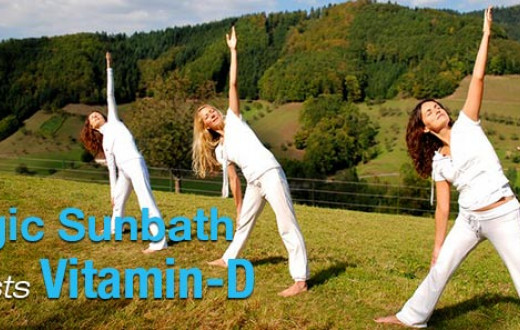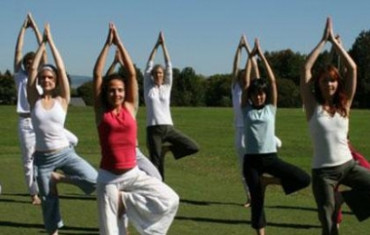Q:How is The Art of Living's yoga different from yoga taught elsewhere?
Yoga is not just an exercise, but it is a state of oneness. This state is achieved through many ways - asana, pranayama, meditation, service, devotion, and knowledge. Sri Sri Yoga emphasizes the holistic aspect of yoga, bringing a difference on all levels of the being - body, mind, and spirit.
Q:What are the benefits of doing yoga?
On a physical level, yogic exercises strengthen, lengthen, and replenish muscle tissues, which helps to hold bones, and to align the whole body. Holding postures - burns fat and reduces cholesterol. Yogic breathing brings more oxygen to the heart and nourishes the whole system. The breath also aids in reducing toxin levels in the body by expelling unwanted stresses. Yoga’s greatest benefits are felt in the mind. We all know that peace of mind is more valuable than an attractive figure. Although the practice of yoga, will definitely improve one’s physical appearance - the best rewards are radiance of a Yogi’s smile, and energetic eyes.
Q:How does one become a yoga teacher?
The Sri Sri Yoga Teacher Training Certification Programs, are an excellent opportunity, for those interested in teaching yoga, or for those who would just like to enrich their spiritual experiences, and bring more discipline in their practice. Sri Sri Yoga teacher training is taught across in Ten days, Successful Completion of Ten days is necessary for Sri Sri Yoga Teacher Certification. Click here for more details.
Q:What is the Health and Happiness workshop?
The Health and Happiness workshop provides practical tools - to achieve, and maintain health and happiness - in our modern, hectic world. This workshop is designed mainly for those, who have not completed the Art of Living Course. About the Health and Happiness workshop:
- Attends to all levels of our physical existence - Body, Breath, and Mind
- Suitable for all age groups and skill levels
- Take-home techniques for greater peace of mind and well being
Q:Benefits – By attending the workshop, you can
- Experience profound healing and relaxation
- Sleep better and smile more
- Lose weight and increase energy
- Increase focus and concentration
- Reduce anxiety and depression
- Maintain harmony in relationships
- Improve your immune system, and overall well-being
Q:What is the minimum age to start yoga?
An infant is a born yogi. Everyone starts practicing yoga right from birth. But as we grow, we forget it. The whole process is of relearning. One can start the basic practice of yoga at 8 years, and after 15 years of age, one can move to advanced stage. Children can learn fun yoga in the Art of Living courses for children:
- ART Excel (All Round Training in Excellence) – For age group 8 to 13. For details see, http://www.artoflivingyouth.org/kidzone.html or contact your Sri Sri Yoga teacher.
- YES (Youth Empowerment Seminar) – For age group 14 to 18. For details see, http://www.artoflivingyouth.org/teenzone.html or contact your Sri Sri Yoga teacher.
Q:Are there any side effects of doing yoga?
When done under proper supervision - of a trained yoga teacher, there are no side effects. If at all, the effects are only positive - as listed in the benefits of doing yoga.
Q:I have heard about Ashtanga Yoga. How do the different forms of yoga vary?
The forefather of yoga, known as “Patanjali”, describes the path of Ashtanga Yoga as an eight-limbed approach - for the well being, and purification of body, mind and soul. The eight-limbs consist of practicing: social ethics, individual ethics, postures, breath control, discipline of the senses, concentration, meditation, and self-realization or equanimity.
Q:Can the practice of yoga help in alleviating incurable diseases?
Yoga is not a substitute for medicine. However, it does help the body-mind complex to cope with stresses. Many patients with incurable diseases have experienced a remarkable transformation, after undergoing our courses. See the section on yoga Experiences.
Q:Is yoga a substitute for curing health problems?
The practice of yoga will bring many health benefits. But do not use yoga, as a substitute, for curing health problems. Take medical advice from your physician.
Q:What is Sukshma Yoga?
Sukshma means delicate or subtle. This system of yoga is very simple, yet powerful in the ability to relax, refresh, and rejuvenate. Sukshma Yoga attends to both internal and external organs of our body - from head to toes - in subtle ways, to bring harmony to the whole system.
Q:Could you explain the significance of the Surya Namaskar?
The Surya Namaskar literally means salutation to the sun. Surya Namaskar is a beautiful set of asanas that massages, detoxifies and stimulates almost every organ of the human body, and brings suppleness to the spine. It can be done fast, as a cardiac toner, or slower to strengthen and tone the muscles, and enhance the functioning of internal organs. It can also be performed with the different mantras (names of the Sun), to give a profound spiritual and meditative aspect. Like all other yoga practices, it is important to learn it under proper supervision and guidance.
Q:What asanas are included in a complete yoga workout?
A complete yoga sequence should comprise of complementary asanas, which help to balance the imbalances in the system. A healthy mix of standing, sitting, and lying down postures, is provided in the Sri Sri Yoga sequences. It is very important to include yoga nidra at the end of any asana sequence, since the body and mind need the time to assimilate the effects of the asanas.
Q:Do you need to go to the gym if you're doing a yoga workout?
Participating in a yoga session, after going to a gym, can help release the stresses, which build up after the exercises. The muscles get toned up, and do not get excessively fatigued. It supplements the gym schedules, and keeps the body from burning out.
Q:What is the difference between yoga and exercise?
In yoga one practices the asanas in a rhythmic manner that involves the body, mind, and spirit. Yoga is like an appointment with the Self, which rejuvenates one’s entire system. It leaves you feeling relaxed and energized. In exercise the focus is more of physical well being. Post an exercise session, one feels exhausted.
Q:What diet complements a daily yoga regime?
The yogic diet is vegetarian and wholesome. The food we eat affects not just our body, but our mind also. Intake of the right amount of food is important - not too little, or too much. Fresh, light, and balanced food are high in prana or energy. The yogic diet consists of fresh fruits, vegetables, nuts, whole grains, lentils, and a small quantity of milk & milk products. See the section on yoga and food for more information.
Q:Does yoga practice prevent diseases?
Yes. A strong immune system is the basis of a healthy body. Yoga helps enhance the immune system, in addition to regulating the various organ systems of the human body. Improper digestion and unhealthy living, creates toxins in the system. Yoga helps to eliminate these toxins, leading to good health. In addition, regular practice of yoga balances the trigunas, having a profound effect on the body-mind complex.
Q:Is practice of yoga asanas enough? Or does one need to study different scriptures on yoga - like Patanjali's Yoga sutras - to get a complete experience?
The field of yoga is like an ocean. Some people come and sit on the shore, enjoying the cool breeze. Some wet their feet. Some swim and surf. Yet others dive deep and get the pearls. It is up to you to decide, how much, and what, you want to do. With the help of an experienced teacher, you can explore the full potential of your life - through yoga.
Q:Is yoga a Hindu practice?
Although yoga has its origins in Hinduism, yoga transcends any religion or culture. Its application is universal. Knowledge, which is scientific or spiritual, has universal application regardless of its origin. For example, the law of gravity was discovered in the West, but its application is universal. It would be foolish of people in the East, to say that they will not use televisions and telephones, just because they were invented in the West. Similarly, it would be very narrow minded to say, that one will not use yoga because it comes from Hinduism - even though its benefits are well known.
Q:What equipment do I need for home practice?
For practicing asanas, you do not require any special equipment - just you and your yoga mat.
Q:Which is the best time for practicing yoga?
The best time to do yoga practice is early in the morning, when your stomach is empty, and you have a minimum number of distractions. It is also recommended that you repeat your practices late in the afternoon, or early evening before dinner. Morning practices keep your enthusiasm and energy levels higher during the day, and evening practices help you get rid of stresses and tensions accumulated during the day – refreshing you.
Q:What are the benefits of regular yoga practice?
Practicing the yoga asanas daily:
- Makes you more productive, calm, and happy
- Enables you to deal effectively with the challenges and stresses of daily life
Q:What should be the duration of a yoga practice session?
Aim at doing your practices - for at least one hour every day in the beginning. If you do not have one hour every day, do your practices for whatever duration you can, however small it may be. Be regular and consistent in your practice. Twenty minutes of daily practice is better than two hours of occasional practice.
Q:Where can I plan to have a safe, comfortable practice?
Do your yoga practices in a clean and well-ventilated space. If possible, keep a separate room for your yoga practices. You will build Divine energy and positive vibrations in that room, which will provide healing, strength, and comfort to you and others. Keep this room a comfortable warm temperature. The body stretches better in warm temperature. However, avoid having the temperature so excessively high, that the body feels uncomfortable, and the mind becomes restless - since this defeats the purpose of yoga. Practice away from furniture, or any sharp objects, so that in the event of an accident, you do not hurt yourself.
Q:How do I justify, the time I spend on myself, doing yoga practice?
A happy person spreads happiness all around. So you are doing these yoga practices - not just for yourself, but for others’ happiness as well. Do not feel guilty for taking time out for yourself. Give yoga an important place in your life. It will bring many rewards.














